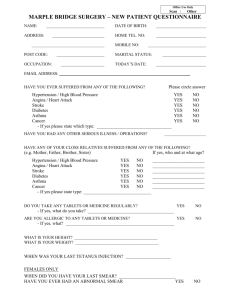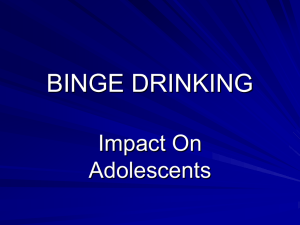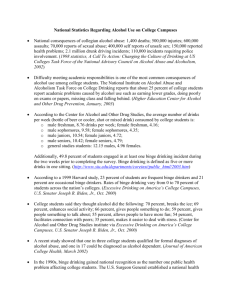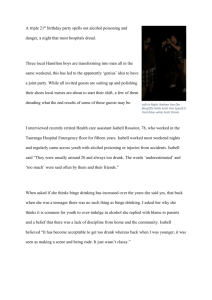Binge drinking is considered a rising problem in today`s
advertisement
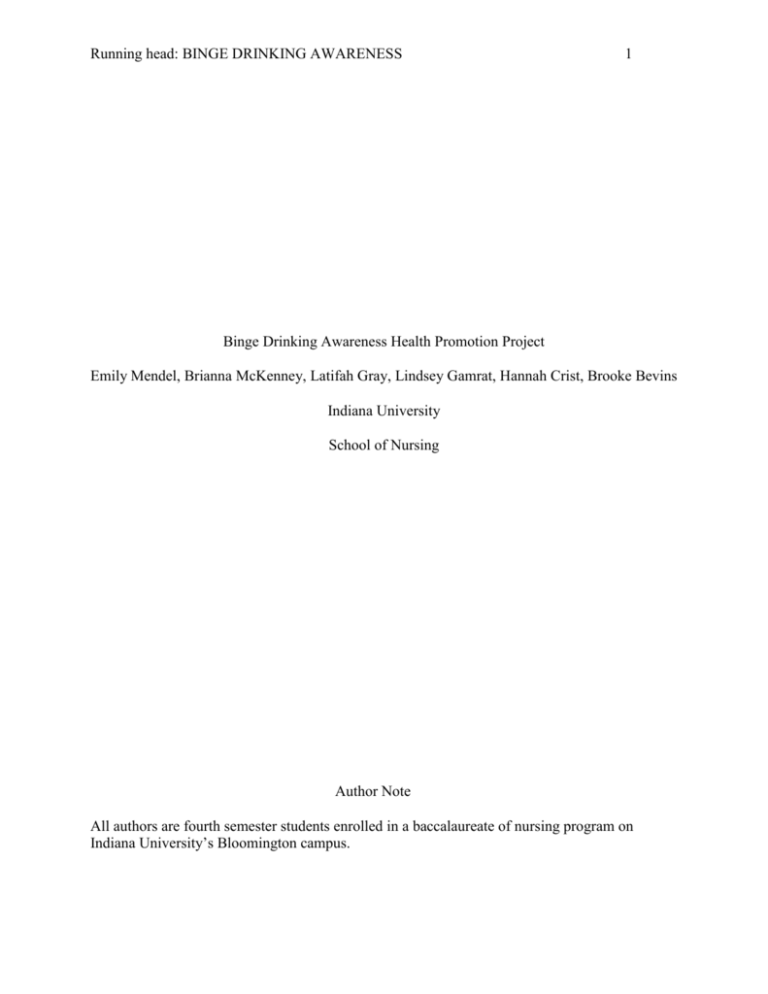
Running head: BINGE DRINKING AWARENESS 1 Binge Drinking Awareness Health Promotion Project Emily Mendel, Brianna McKenney, Latifah Gray, Lindsey Gamrat, Hannah Crist, Brooke Bevins Indiana University School of Nursing Author Note All authors are fourth semester students enrolled in a baccalaureate of nursing program on Indiana University’s Bloomington campus. BINGE DRINKING AWARENESS 2 Abstract Binge drinking is a highly prevalent problem in society that can lead to a large number of negative consequences. Addressing the issues that contribute to one’s drinking is the first step in initiating an intervention. The presenting group provided an educational event on binge drinking as an intervention to a group of college students. The audience felt as though the content of the presentation was relative and appropriate for their particular demographic. The presenting group gained practice in community education to use in their future nursing careers as well as felt satisfied that they provided a successful intervention to educate their audience. Keywords: alcohol awareness, binge drinking, college students, health promotion, service learning BINGE DRINKING AWARENESS 3 Binge Drinking Awareness Health Promotion Project Binge drinking is considered a rising problem in today’s society that is mainly seen in the young adult population. The group, in efforts to educate the public of this problem, conducted a presentation about binge drinking to college freshman women and men in a dormitory. In creating the presentation, the Health Belief Model was a tool used to help with identifying the needs of the target population in order to better help the group meet the needs of the individuals (Edelman & Mandle, 2010). The goal of the presentation was to provide safe drinking tips and alternatives to binge drinking in order to decrease the amount of binge drinking and also increase safety in situations where alcohol is consumed. A questionnaire was used during the presentation to help the men and women evaluate their own drinking habits as well as relay to the presenting group what knowledge they gained during the presentation. Many of the students did not know what binge drinking truly was; so because of the lack of knowledge they had, they participated in it. Background Binge drinking is a problem that is all too common in society; especially among college campuses. The Center for Disease Control and Prevention states that binge drinking is defined as a “pattern of drinking that brings a person’s blood alcohol concentration (BAC) to 0.08 grams percent or above” (CDC, 2010). This typically occurs when within a two hour time frame, a male consumes five or more drinks or a female consumes four or more drinks (CDC, 2010). One drink is defined as one 12-ounce bottle of beer or wine cooler, one 5-ounce glass of wine, or 1.5 ounces of 80-proof liquor (NIAAA, 2012). The prevalence of binge drinking in the United States is astonishingly high. Of adults who drink, 92% have reported binge drinking in the past 30 days. Of all alcohol consumed by BINGE DRINKING AWARENESS 4 adults, 75% is in the form of binge drinks. As for youth under 21 years of age, 90% of alcohol they consume is in the form of binge drinks. In fact, 51% of all binge drinkers fit into the 18-20 age group (CDC, 2010). According to Edelman and Mandle, 24% of young adults have admitted to binge drinking in the past 30 days and alcohol consumption rates are increasing. Young adults usually drink less frequently than adults, but when they do they consume much larger amounts of alcohol (Edelman and Mandle, 2010). As for young adults who attend college, more than 40% have engaged in binge drinking in the past two weeks (NIAAA, 2012). Men are more likely than women to engage in binge drinking. Despite the high amount of alcohol involved though, studies have shown that most people who binge drink are not alcohol dependent (CDC, 2010). Binge drinking has long been associated with many negative consequences. The Centers for Disease Control and Prevention outline some of the major health risks as injury (both intentional and unintentional), alcohol poisoning, sexually transmitted diseases, unintended pregnancy, babies born with fetal alcohol syndrome, cardiovascular problems, liver disease, sexual dysfunction, neurological damage, and poorly controlled diabetes (CDC, 2010). The National Institute on Alcohol Abuse and Alcoholism points out that college binge drinkers have an increased risk for many adverse effects in addition to the health consequences such as sexual abuse, injuries, assault, unsafe sex, academic problems, and vandalism (NIAAA, 2012). Healthy People 2020 has set several objectives to decrease substance abuse such as binge drinking. In regards to adolescents, they would like to increase the number who refrain from using alcohol, who disapprove of alcohol use by peers, and who perceive great risk associated with alcohol abuse. They would like to decrease the number of adolescents who reported using alcohol in the past 30 days and decrease the prevalence of binge drinking overall. This would include adolescents, college students and adults. Along with these goals, they hope to decrease BINGE DRINKING AWARENESS 5 the annual alcohol consumption, decrease instances of impaired driving, decrease the number of deaths attributed to alcohol, and increase the number of people who receive treatment for alcohol abuse (United States Department of Health and Human Services, 2012). The health belief model is a set of criteria that is used to predict and explain behaviors and determine how able an individual is to act on behalf of his or her own health. There are seven elements that make up the health belief model. According to Edelman and Mandle, the components of this model include individual perceptions and readiness to change, how much the individual values health, perceived susceptibility to a health problem, perceived seriousness of the disease, risk factors for a disease, perceived benefits of health action, and perceived barriers to promotion action” (2010). This model is important to health care professionals because it helps to identify the needs of individuals and the things that can be done to help the individual make healthy changes. It shows an individual’s values and beliefs; which are then used as a guide to help form action plans and educational methods that the individual is more likely to follow (Edelman & Mandle, 2010). Edelman and Mandle state that the model can be used to “explain responses to symptoms, disease, prescribed treatments, and potential health problems” (2010). The Health Belief Model was used as the foundation for this project with the purpose of creating and evaluating a program concerning binge drinking. The model helped identify the target population and some of the reasons as to why this certain population engages in binge drinking. It also aided in identifying the educational needs of the population and how effective the education might be. BINGE DRINKING AWARENESS 6 Intervention During the presentation, several drinking habits and ways to help modify characteristics that can lead to binge drinking were discussed. Addressing the issues that contribute to one’s drinking is the first step in initiating an intervention. There are some aspects that students cannot change such as gender, genetics, and past experiences just to name a few; but there are many aspects that can be altered. Making adjustments to one’s surroundings, such as new friends, new environment and different ways to cope with issues can be a good start in modifying drinking habits. Whether a person decides to stop drinking alcohol or not, the goal of the presentation was to speak about nontoxic ways to drink if students do decide to consume alcohol. Practicing safe drinking can potentially save lives; whether it’s the person drinking or others around them. Setting a limit to how many drinks one will have and assigning a designated driver are positive behaviors in making sure that an individual is secure and protected against harm (Engs, 1987). Eating high-protein foods before having a drink can reduce the absorption time of alcohol and prevent becoming too intoxicated. Keeping one’s drink within sight around other people and not accepting drinks from anyone can prevent the risk of poisoning or added drugs to the drink (Engs, 1987). These are all examples of practicing safe drinking. The CAGE questionnaire is a tool to identify a person’s outlook on his or her drinking habits. The C stands for feeling the need to cut down on drinking. The A stands for feeling annoyed by other’s criticism of one’s drinking. The G stands for having guilty feelings towards drinking; and finally the E stands for needing a morning eye opener after drinking the night before (Edelman & Mandle, 2010). The presenting group presented this questionnaire to an audience to obtain their viewpoints of their own drinking habits. If a person answered yes to two or more of the questions presented above, then they may have a binge drinking problem. Many BINGE DRINKING AWARENESS 7 resources are available to assist students in obtaining help in regards to their destructive drinking habits. As stated earlier, the Health Belief Model (HBM) is a model that addresses the relationship between a person’s beliefs and behaviors. If a student does not believe that they have a binge drinking problem, then they are most likely not willing to change or choose healthier behaviors. Students’ perceptions of the seriousness of binge drinking as well as their susceptibility to being harmed can influence their actions to improve habits. The HBM helped the presenting group understand how the individuals may view their own health and what actions they may need to take to better their well-being. An individual’s perceptions, modifying factors, and their likelihood of action all contribute to whether or not they will take part in preventing illnesses and choosing a healthier way of living (Edelman & Mandle, 2010). Outcomes The CAGE questionnaire was distributed to the audience present at the group’s presentation. There were a total of eleven students present. There were students ranging from nineteen to twenty-one years of age. Ten of the students were female and one was male. The students were asked to answer YES or NO to four questions relating to their drinking habits. One student does not engage in drinking alcohol so she was not able to answer the following questions. The students were asked: Have you ever felt you should cut down on your drinking? Every student answered NO. The presenting group asked the question: Have people annoyed you by criticizing your drinking? Four students answered NO, while six students answered YES to the question. The students were asked: Have you ever felt bad or guilty about your drinking? Two students have felt guilty, while the other eight have not felt guilty. The final question asked BINGE DRINKING AWARENESS 8 was: Have you ever had a drink first thing in the morning to steady your nerves or get rid of a hangover? Everyone responded NO to the question asked. The presenting group debriefed after the presentation about what went well as well as the aspects that they could have better improved. The group decided that the equipment used to display the presentation could have been prepared in advance. This would have eliminated the issue of beginning after the scheduled time due to technical difficulties. The group could also have been more prepared by having their slides memorized, rather than reciting the information verbatim off the slide. It probably would have been more of an effective interaction if the group had used strategies that would have engaged the audience. The audience did feel as though the content of the presentation was relative and appropriate for their particular demographic. Many of the students stated that before the presentation, they did not know what binge drinking consisted of. It was brought to the student’s attention how easily it was to drink the particular amount of alcohol that is considered binge drinking. The students felt like the videos in the presentation were very effective and relative to the subject matter. Nursing Implications Theory is tied to community service because it provides perspective into the approach in which a program or convention could be presented to the community. The Health Belief Model allowed the presentation to be geared towards educating the public on their perceived susceptibility and dangers. At the same time, however, the group offered a way to continue drinking without falling prey to those circumstances. There was an evident community need for this type of education. Many of the girls living on this floor were going into the Greek system and were frequently exposed to binge drinking and alcohol on a regular basis. The students were BINGE DRINKING AWARENESS 9 able to write on the bottom of their evaluations what parts of the presentation they learned from, and it was evident that the students gained a better understanding on what binge drinking really was. The presenting group and students were both able to reflect on the presentation by evaluations filled out by the students and reviewed by the group. The problem with some of the presentation was that much of the information has already been taught to the students due to a mandatory program that they had to complete prior to beginning freshman year called AlcoholEdu. This could also be considered as a strength with backing up AlcoholEdu knowing about binge drinking. Another strength to be considered from the presentation was how the group addressed safer ways to consume alcohol because it was realistically more effective rather than trying to teach them not to drink at all. This project was effective in meeting a community need for education and backing up previous education, but future reaching out to different populations would also be beneficial. Taking the presentation to high school seniors to give them awareness before they head to college or having similar presentations in all of the dormitories within the first month of school would expose the new college students to the realities of drinking and safe drinking habits. Also, setting up class visit presentations in collaboration with professors may be beneficial to ensure that the presenters would have a large group to reach out to. BINGE DRINKING AWARENESS 10 References Centers for Disease Control and Prevention (CDC). (2010, July 20). Fact sheets: Binge drinking. Retrieved from http://www.cdc.gov/alcohol/fact-sheets/binge-drinking.htm Edelman, C.L. & Mandle, C.L. (2010). Health Promotion through the lifespan (7th ed.). St. Louis : Mosby. Engs, R. C. (1987). Alcohol and other drugs: Self responsibility. Manuscript submitted for publication, Indiana University, Bloomington, IN. Retrieved from http://www.indiana.edu/~engs/hints/holiday.html National Institute on Alcohol Abuse and Alcoholism (NIAAA). (2012, February). Statistical snapshot of college drinking. Retrieved from http://www.niaaa.nih.gov/Pages/default.aspx United States Department of Health and Human Services (2012). Substance abuse. Retrieved from http://healthypeople.gov/2020/topicsobjectives2020/objectiveslist.aspx?topicid=40 BINGE DRINKING AWARENESS 11 Appendix A Group Rules 1. If someone does not show up to the presentation then they will have 25% taken off of their grade for the presentation. This is not implemented if there is a valid excuse for missing the presentation. 2. If someone does not show up to the presentation they will also have 25% taken off of their final grade. This is not implemented if there is a valid excuse for missing the final presentation. 3. If an email is sent before 6pm that day, it should be responded to that day if appropriate. However, if the email is sent later than 6pm, group members must respond to the email within 24 hours. If group members do not implement this, it will be taken into consideration when giving group evaluations. 4. If a group member does poorly on the paper and is asked to redo her section of the paper, she must put in quality effort to fix her section or 5% will be taken off this paper’s grade. BINGE DRINKING AWARENESS 12 Appendix B Results CAGE Questionnaire Responses N=11 No Cutting down 0 (0%) Yes 11(100%) Annoyed by criticism 4 (36%) 7 (64%) Guilty feelings 2 (18%) 9 (82%) Eye opener 0 (0%) 11(100%) .


